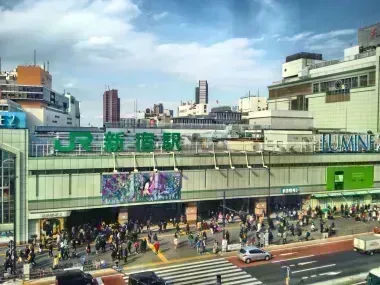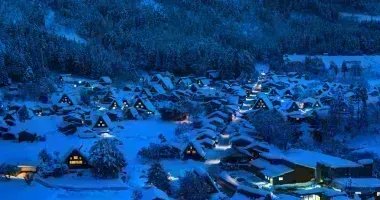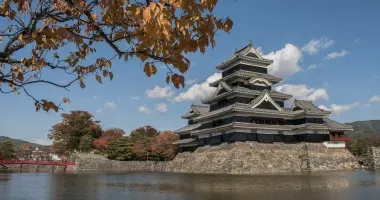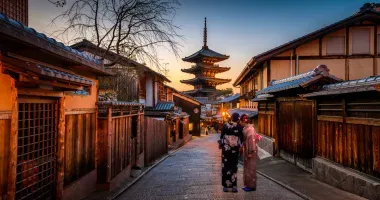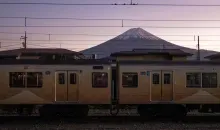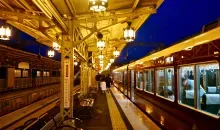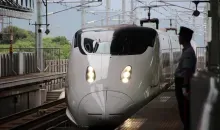How to get from Tokyo to Otsuki
From the iconic Shinjuku Station, the JR Chuo Main Line has limited express train options for getting from the world's busiest train station out to the much more subdued and tranquil Otsuki in Yamanashi.
Getting from Tokyo to Otsuki with JR Chuo Main Line
Otsuki Station
Getting from Tokyo to Otsuki with the Chuo Main Line
With just one train, the entire vibe of your trip to Japan will change with a trip from Tokyo to Otsuki! Tokyo, as the world’s largest metropolitan area, is as urban as it gets. Dense concentrations of buildings that are home to interesting storefronts, restaurants, and residences make it one of the world’s most premier destinations. But take the Chuo Main Line, and the city of Otsuki in Yamanashi Prefecture introduces a much more subdued side of Japan that most would only see in film or pictures. Surrounded by mountains with the iconic Mount Fuji in the background, Otsuki is a city that exists alongside nature and serves as a gateway to the past, with many ancient Jomon artifacts being found within the city grounds.
From Shinjuku Station, the world’s busiest train station, the Kaiji and Azusa Limited Express Trains can be ridden out via the JR Chuo Main Line. The journey takes around one hour with the Kaiji and Azusa trains, but for local Chuo Line trains, it can take up to two hours.
Trains available on this itinerary:
| Kaiji Limited Express Train | Azusa Limited Express Train | Chuo Main Line Special Rapid Train |
Reserving seats on the Limited Express Trains
On JR Chuo Limited Express Trains, individual ticket holders and holders of Japan Rail Passes can reserve seats in advance of boarding. Reservations are not always required for these because many of them have non-reserved cars with seats that are available on a first-come, first-served basis. These are often car numbers 1-4.
JR Limited Express Trains have tickets available with reserved seats to assure room for sitting during transit.
Oversized Baggage on Limited Express Trains
Unlike on Tokaido-Sanyo Shinkansen bullet trains, there are no specific oversized baggage rules on Limited Express Trains or other Shinkansen lines like the Hokuriku Shinkansen. However, we do advise being mindful of large and heavy luggage when traveling to optimize ease of movement and reduce any inconvenience to other commuters.
On JR Tokaido-Sanyo Shinkansen bullet trains, oversized luggage is considered any piece of baggage at 160cm or more in total dimensions, so be aware that luggage that fits this description may be more difficult to find storage for on trains in Japan. If other itineraries on your journey include riding the Tokaido-Sanyo Shinkansen, be aware that special regulations for reserving use of the oversized luggage compartment will be in place for those commutes.
Exploring Tokyo
Before the Meiji Restoration, Edo was the name of the capital city of Japan, which is now named Tokyo. Its diverse and rich culture is a fitting reflection of the fact that it is currently the world's most populous city. This metropolitan area offers something for everyone, with bustling activity in its more central locations and calm, cozy neighborhoods strewn throughout.
Akihabara and Nakano are great places for fans of anime and Japanese popular culture to find a second home. Roppongi offers plenty of activities for those seeking a night on the town. Trendy areas like Kichijoji and Shimokitazawa offer a glimpse into the tastes of Tokyo's trendy people, and Ginza and Higashi Azabu are definitely must-visits for anyone looking to spend a day indulging in upscale dining and shopping.
Tokyo's vast public transit system, which makes getting around the city easy, is one of the city's main attractions. This is particularly for JR Pass holders, who will have unrestricted use of the JR Lines both inside Tokyo and while leaving. The Shinkansen Bullet Train stops at Tokyo Station, Shinagawa Station, and Ueno Station.
To get to Otsuki from Tokyo, the Chuo Main Line bullet train is ridden from Shinjuku Station, the busiest train station in the world, with upwards of 3.5 million people commuting through it daily. The surroundings of Shinjuku Station are a treasure trove of discovery, with quality shopping, nice restaurants, and other spots to keep anyone entertained all around.
Exploring Otsuki
Yamanashi Prefecture is one of the prefectures that can claim to be home to Mount Fuji, with neighboring Shizuoka being the other. With this, the prefecture is a popular retreat for visitors to the country as well as Japanese residents alike. The culture and natural landscapes in Yamanashi are immaculate, and the abundance of hot springs throughout the prefecture are the perfect spots to take it all in.
Otsuki City, right in the heart of Yamanashi, is one direct train away from Shinjuku Station in Tokyo, but despite how well-connected the two are, they are worlds apart in terms of atmosphere. Where Tokyo has urban fixtures aplenty, the buildings in Otsuki exist within the shadow of the towering mountains that the city is built around. These mountains are home to a number of hiking trails and nature walks. Mount Iwadono is likely the most famous within the city’s proximity, but its grandiose presence ought not intimidate, as the hike up to the summit is relatively gentle, taking only around 45 minutes and being worth the effort to take in the immaculate views of the area. On a clear day, Mount Fuji can be seen. Though the ideal parameters for the iconic landmark to show up are a bit rare, it comes as a pleasant surprise when it does come into view.
Other great spots to take in the nature of the area include the Saruhashi Bridge and Taro Jiro Falls. Saruhashi Bridge is notable for its unique architecture, built by the linking of the arms of the monkeys in the area of Otsuki, as the legend goes. The intriguing design has it designated as one of the three “unusual bridges” of Japan. Below, the rock formations and rushing river can be seen. Taro Jiro Falls is a relatively easy spot to access for those visiting Otsuki. The location actually consists of two separate waterfalls that go into the valley river. The name is derived from an alleged pair of brother bandits that operated out of the area in the olden days. Apparently, rather than face arrest when law enforcement caught up to them, the two decided to jump off the respective waterfalls. The legend continues to this day, but with the names “Taro” and “Jiro” being relatively common monikers for boys in historic Japan, the validity of the tale is up to question, but the spirit of the event lives on with the synonymity of the natural landmark with the city of Otsuki.
Otsuki City is largely served by Otsuki Station, modestly constructed with wood to reflect the nature-rich surroundings. From Tokyo, the JR Chuo Main Line is the primary means of access, with slow local trains and special express trains both being options. All the way from Narita Airport in Chiba Prefecture, the Narita Express has a few trains that will make stops at Otsuki.
From Skyscrapers to Mountains
Seeing Tokyo and then trekking out to Otsuki can give travelers a sense of whiplash. The fact that the two destinations are a short, one train trip away from each other is also hard to believe, but a testament to the efficiency of Japan's train network. Take a ride on the JR Chuo Main Line and see both Japan's major metropolitan capital as well as the rich nature that takes up a vast majority of the country!

